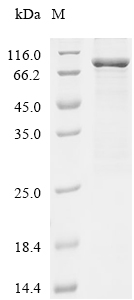Shopping Cart
Remove All Your shopping cart is currently empty
Your shopping cart is currently empty
PNPLA2 Protein, Human, Recombinant (His & SUMO) is expressed in E. coli expression system with N-6xHis-SUMO tag. The predicted molecular weight is 71.3 kDa and the accession number is Q96AD5.

| Pack Size | Price | USA Warehouse | Global Warehouse | Quantity |
|---|---|---|---|---|
| 5 μg | $105 | 20 days | 20 days | |
| 10 μg | $169 | 20 days | 20 days | |
| 20 μg | $283 | - | In Stock | |
| 50 μg | $428 | 20 days | 20 days | |
| 100 μg | $590 | - | In Stock | |
| 200 μg | $913 | 20 days | 20 days | |
| 500 μg | $1,620 | 20 days | 20 days | |
| 1 mg | $2,530 | 20 days | 20 days |
| Biological Activity | Activity has not been tested. It is theoretically active, but we cannot guarantee it. If you require protein activity, we recommend choosing the eukaryotic expression version first. |
| Description | PNPLA2 Protein, Human, Recombinant (His & SUMO) is expressed in E. coli expression system with N-6xHis-SUMO tag. The predicted molecular weight is 71.3 kDa and the accession number is Q96AD5. |
| Species | Human |
| Expression System | E. coli |
| Tag | N-6xHis-SUMO |
| Accession Number | Q96AD5 |
| Synonyms | TTS2.2,Transport-secretion protein 2 (TTS2),PNPLA2,Pigment epithelium-derived factor receptor (PEDF-R),Patatin-like phospholipase domain-containing protein 2,Desnutrin,Calcium-independent phospholipase A2-zeta (iPLA2-zeta),ATGL,Adipose triglyceride lipase |
| Amino Acid | MFPREKTWNISFAGCGFLGVYYVGVASCLREHAPFLVANATHIYGASAGALTATALVTGVCLGEAGAKFIEVSKEARKRFLGPLHPSFNLVKIIRSFLLKVLPADSHEHASGRLGISLTRVSDGENVIISHFNSKDELIQANVCSGFIPVYCGLIPPSLQGVRYVDGGISDNLPLYELKNTITVSPFSGESDICPQDSSTNIHELRVTNTSIQFNLRNLYRLSKALFPPEPLVLREMCKQGYRDGLRFLQRNGLLNRPNPLLALPPARPHGPEDKDQAVESAQAEDYSQLPGEDHILEHLPARLNEALLEACVEPTDLLTTLSNMLPVRLATAMMVPYTLPLESALSFTIRLLEWLPDVPEDIRWMKEQTGSICQYLVMRAKRKLGRHLPSRLPEQVELRRVQSLPSVPLSCAAYREALPGWMRNNLSLGDALAKWEECQRQLLLGLFCTNVAFPPEALRMRAPADPAPAPADPASPQHQLAGPAPLLSTPAPEARPVIGALGL |
| Construction | 1-504 aa |
| Protein Purity | > 90% as determined by SDS-PAGE.  |
| Molecular Weight | 71.3 kDa (predicted) |
| Endotoxin | < 1.0 EU/μg of the protein as determined by the LAL method. |
| Formulation | Tris-based buffer, 50% glycerol |
| Reconstitution | A Certificate of Analysis (CoA) containing reconstitution instructions is included with the products. Please refer to the CoA for detailed information. |
| Stability & Storage | Lyophilized powders can be stably stored for over 12 months, while liquid products can be stored for 6-12 months at -80°C. For reconstituted protein solutions, the solution can be stored at -20°C to -80°C for at least 3 months. Please avoid multiple freeze-thaw cycles and store products in aliquots. |
| Shipping | In general, Lyophilized powders are shipping with blue ice. Solutions are shipping with dry ice. |
| Research Background | Catalyzes the initial step in triglyceride hydrolysis in adipocyte and non-adipocyte lipid droplets. Exhibits a strong preference for the hydrolysis of long-chain fatty acid esters at the sn-2 position of the glycerol backbone. Also has acylglycerol transacylase activity. Acts coordinately with LIPE/HLS and DGAT2 within the lipolytic cascade. Transfers fatty acid from triglyceride to retinol, hydrolyzes retinylesters, and generates 1,3-diacylglycerol from triglycerides. Regulates adiposome size and may be involved in the degradation of adiposomes. May play an important role in energy homeostasis. May play a role in the response of the organism to starvation, enhancing hydrolysis of triglycerides and providing free fatty acids to other tissues to be oxidized in situations of energy depletion. |
| Size | Quantity | Unit Price | Amount | Operation |
|---|

Copyright © 2015-2026 TargetMol Chemicals Inc. All Rights Reserved.